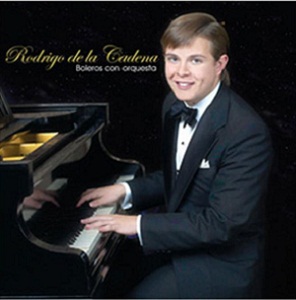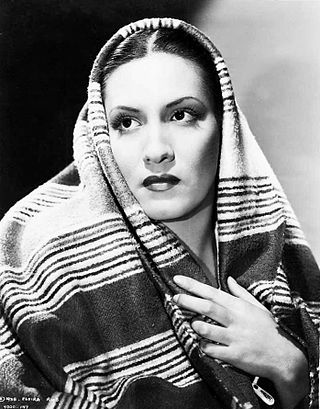
The music of Mexico is highly diverse, featuring a wide range of musical genres and performance styles. It has been influenced by a variety of cultures, primarily deriving from Europeans, Indigenous, and Africans. Music became an expression of Mexican nationalism starting in the nineteenth century.

Originally, Trio Los Panchos were a trío romántico formed in New York City in 1944 by Alfredo Gil, Chucho Navarro, and the Puerto Rican Hernando Avilés. The trio became one of the leading exporters of the bolero and the romantic ballad in Latin America.

Ángel Agustín María Carlos Fausto Mariano Alfonso del Sagrado Corazón de Jesús Lara y Aguirre del Pino, known as Agustín Lara, was a Mexican composer and performer of songs and boleros. He is recognized as one of the most popular songwriters of his era. His work was widely appreciated not only in Mexico but also in Central and South America, the Caribbean and Spain. After his death, he has also been recognized in the United States, Italy, and Japan.

Mexican recording artist Luis Miguel has released 21 studio albums, 30 compilation albums, three extended plays (EP) two live albums, two soundtrack albums and five box set. Luis Miguel has sold over 60 million records, making him one of the best-selling Latin music artists of all time. Luis Miguel is also the artist with the second-most number ones on the Billboard Top Latin Albums chart with nine albums. At the age of 11, he released his debut studio album, Un Sol (1982), which was certified platinum and gold in Mexico. The artist would release four more studio albums under the record label EMI: Directo al Corazón (1982), Decídete (1983), También es Rock (1984), and Palabra de Honor (1984). A Portuguese-language version of Decídete and Palabra de Honor were released in Brazil as Decide Amor and Meu Sonho Perdido, respectively. Luis Miguel made his acting debut in the film as the lead role on Ya nunca más (1984) and recorded its soundtrack. In 1985, he participated in the Sanremo Music Festival 1985 with the song "Noi ragazzi di oggi"; it placed second in the Big Artist category and was later included on the Italian-language edition of Palabra de Honor. In the same year, Luis Miguel recorded the soundtrack for the film Fiebre de amor, which he co-starred with fellow Mexican singer Lucero.

Romance is the eighth studio album by Mexican singer Luis Miguel. It was released by WEA Latina on 19 November 1991. Although the production was originally intended as another collaboration with Juan Carlos Calderón, that plan was scrapped when Calderón was unable to compose songs for the album. Facing a new-material deadline in his recording contract, at his manager's suggestion Miguel chose bolero music for his next project. Mexican singer-songwriter Armando Manzanero was hired by WEA Latina to co-produce the album with Miguel. Recording began in August 1991 at Ocean Way Recording in Hollywood, California, with Bebu Silvetti the arranger.

Pedro Vargas Mata was a Mexican tenor and actor, from the golden age of Mexican cinema, participating in more than 70 films. He was known as the "Nightingale of the Americas", "Song Samurai" or "Continental Tenor".

Antonia del Carmen Peregrino Álvarez, known by her stage name Toña la Negra, was a Mexican singer and actress of partial Haitian ancestry, known for her interpretation of boleros and canciones written by Agustín Lara.

Mis Boleros Favoritos is a compilation album by Mexican singer Luis Miguel. Released on 8 October 2002 by Warner Music Latina, it contains thirteen previously-recorded songs from the Romance-themed albums as well as a new track "Hasta Que Vuelvas". A special edition of the record was released on the same day and includes a DVD containing seven music videos from the bolero-themed discs. "Hasta Que Vuelvas" was released as a single for the album and peaked at number 16 on Billboard's Hot Latin Songs chart in the United States. Iván Adaime of AllMusic gave the album a 3.5 out of 5 star rating citing that the new song and music videos are the only incentives for fans to buy it and noted the album's purpose to end the Romance era. "Hasta Que Vuelvas" received a Latin Grammy nomination for Record of the Year in 2003. Commercially, Mis Boleros Favoritos peaked at number three on Billboard's Top Latin Albums chart in the United States, number one in Spain, and number seven in Argentina.

Nuevamente... El Bolero is the first solo album by artist Rodrigo de la Cadena. It was first released in 2005. Out of the 12 songs released on this album, there were over 30 demos of different compositions by Agustín Lara, Luis Demetrio, Armando Manzanero, etc. Sessions took place at Discos Orfeon.

Boleros Con Orquesta is the second solo album by artist Rodrigo de la Cadena. It was originally intended to be released in late 2006, but because of the difficulty of schedule of his international tour it was delayed until January 2007. The bonus and final two tracks of the album were recorded only by his piano and voice in a rare studio session that took place in 2005.
Rodrigo Prats was a Cuban composer, arranger, violinist, pianist and orchestral director.
María Dussauge Ortiz, commonly known as María Duval, is a Mexican actress and singer who has worked in film, television, and the stage.

Hasta la Raíz is the fifth studio album by Mexican recording artist Natalia Lafourcade, released on March 17, 2015, through Sony Music Mexico. After the success of her previous album, Mujer Divina – Homenaje a Agustín Lara, a tribute to Mexican singer-songwriter Agustín Lara, Lafourcade decided to record an album with original recordings. Lafourcade spent three years writing the songs and searching for inspiration in different cities, resulting in songs that express very personal feelings regarding love. The record was produced by Lafourcade, with the assistance of Argentinian musician Cachorro López and Mexican artist Leonel García.
Eva Garza was a Mexican-American singer and film actress who acquired international recognition in the 1940s and 1950s during the Golden Age of Mexican cinema. She collaborated on live radio shows and films with some of the leading performers of her time, including Mexico's Agustín Lara. She was nicknamed "Sweetheart of the Americas".

María Elvira Gallegos Ríos was a Mexican singer and actress.
María Marcelina Rebeca Silva Cosío, known as Rebeca or Rebeca Silva Cosío, was a Mexican singer who was the last official vocalist of songwriter and pianist Agustín Lara. She also introduced and recorded Lara's final songs.
Néstor Mesta Cháyres was an acclaimed tenor in Mexico and a noted interpreter of Spanish songs, boleros and Mexican romantic music on the international concert stage. He was widely commended for his artistic renditions of the works of Agustín Lara and María Grever and was nicknamed "El Gitano de México".

Juan Nepomuceno Arvizu Santelices, was an acclaimed lyric tenor in Mexico and a noted interpreter of the Latin American bolero and tango on the international concert stage, on the radio and in film. He was widely noted for his interpretations of the works of Agustin Lara and María Grever and was nicknamed "The Tenor With the Silken Voice".
María Guadalupe Silva Cosío, known professionally as Lupe Silva, was a Mexican singer and actress. She was the last singer who collaborated with songwriter and pianist Agustín Lara. Her sister, singer Rebeca Silva Cosío, also collaborated with Lara.
Alma Graciela Haro Cabello, known professionally as Esmeralda, was a Mexican singer and actress. She was nicknamed La Versátil because she sang and recorded songs of various music genres, including cuplé, bolero, and tango.













